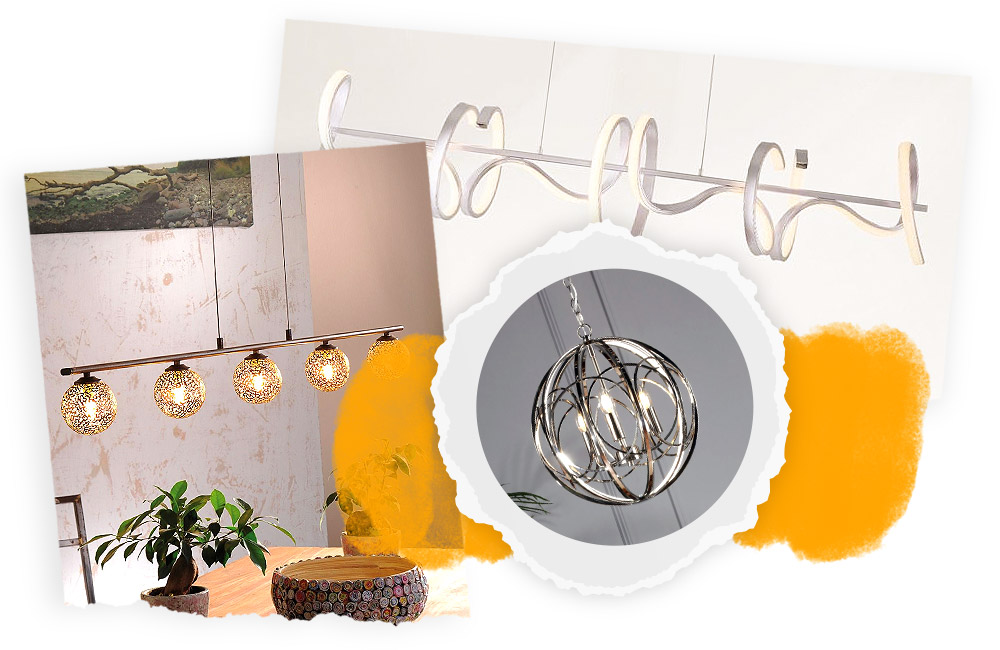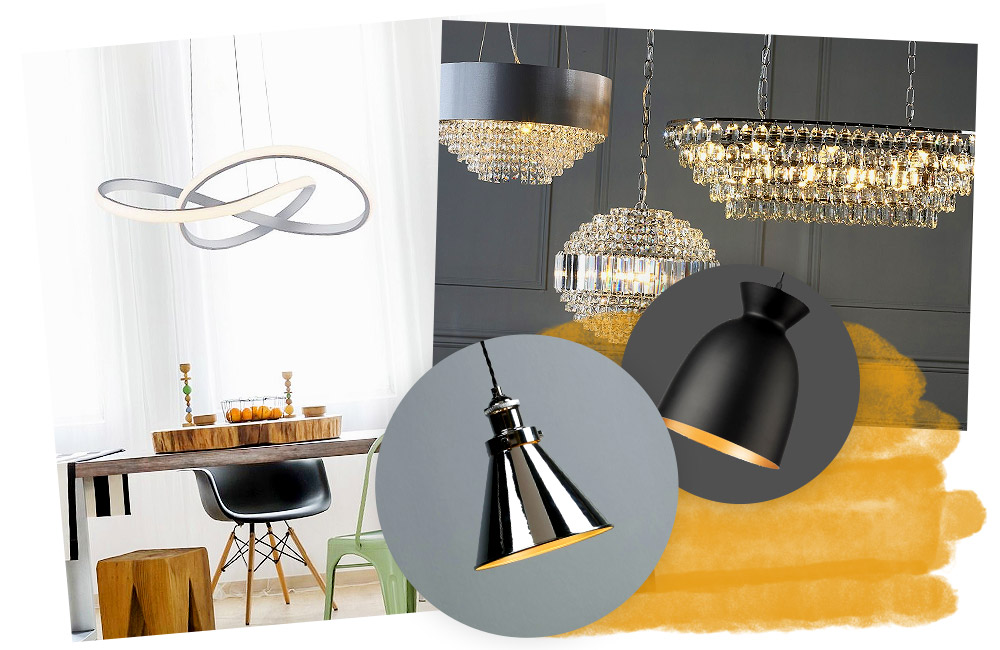Illumination can make a huge impact in a room. Used correctly, it adds a subtle ambience to the decor, making the space warm and inviting. Although it's fashionable to concentrate on installing hazy pools of light to accentuate wooden flooring or objets d'art, it's equally important to have a room well-lit. Ceiling lights are a practical form of illumination as they usually cast the widest glow, making the space clear and bright. Ceiling pendant lights should complement the dimensions of the room and maintain a sense of proportion. A simple mathematical formula is all that's needed to determine which size ceiling lights are the most suitable.
Different Types of Ceiling Lights
Before measuring, consider which lighting style would enhance the room. Traditional ceiling pendant lights usually hang from the ceiling by an electrical cable or chain. The designs usually include a single light fitting with one bulb, or radial spokes to accommodate at least three bulbs.
Ceiling pendant clusters usually feature one fitting and multiple cables complete with bulbs. These can be draped across the ceiling with the bulbs falling at a variety of heights. Although the current industrial trend leaves the bulbs exposed, the clusters can include stylish shades.

It's popular to have a row of around three light fittings to follow the line of a breakfast bar or table. An alternative is the ceiling pendant bar. It's designed for one light fitting, but features a long bar of wood or metal with multiple bulbs.
A rise and fall pendant light is a versatile choice. It operates through a counterweight system that raises the light for a wide, bright illumination, or lowers it for a narrow, soft glow.
Recessed and semi-flush ceiling lights are ideal for low ceilings or areas where a clear view is preferred. A recessed light fits inside the ceiling, creating a smooth, uncluttered image without any visible cables. A semi-flush light is fixed onto the ceiling, leaving the three-dimensional structure visible, but without any trailing wires. An alternative is to install track lighting where several small lights are placed along a bar that fits neatly against the ceiling. Individual lights can usually be moved along the track to provide bright pools of light.
How to Measure for Ceiling Pendant Lights
Using a standard formula couldn't be easier when choosing the best sized ceiling lights. Measure the room's length and width in feet. Surplus inches should be rounded up or down accordingly. Add the two results together, then convert to inches. Here is an example:
Room Length 14 feet + Room Width 10 feet = 24 feet, becomes 24 inches.
In this example, 24 inches represents the diameter of the light fitting or shade. Another measurement is now required to determine the height of the fitting. Measure from floor to ceiling to find out the height of the room, rounding up or down any leftover inches. This figure then needs to be multiplied by 2.5 and 3 before exchanging feet for inches. As an example:
Room Height 8 feet x 2.5 and 3 = 20 and 24 feet, becomes 20 and 24 inches.
The measurements indicate the fitting should have a diameter of 24 inches and a height of between 20 and 24 inches to complement the proportions of the room.
How to Measure for Recessed Ceiling Lights

Recessed flush ceiling lights are generally smaller than pendant lights. The glow they cast is often narrow, requiring several lights to be evenly distributed across the ceiling. To work out how many recessed lights are required, measure the height of the room and divide the result by two. The answer indicates how widely spaced the lights should be. An easy example is as follows:
Ceiling Height 8 feet, divide by 2 = 4, = spacing of 4 feet.
The exact number of lights depends on the room's dimensions, and the preferred intensity of light. However, if a room can accommodate four lights along the length and three on the width, multiply the two figures together to get a total of twelve lights, which indicates an adequate amount.
How Much Light is Required in a Room?
Lower amounts of electricity are used with LED ceiling light fittings compared to long-life fluorescent tubes. Light Emitting Diode (LED) bulbs are approximately 80% more efficient. They emit light when electrcity passes through a microchip. It's an economical method that converts around 95% of its energy into illumination with just 5% being lost as unusable heat. On average, LED bulbs have a longevity of 100,000 hours, and in many instances may last up to twenty years.
The light output of LED bulbs is measured in lumens. The higher the lumens rating, the brighter the illumination. Generally, there should be around 250 lumens for every square metre of a room. Typical examples of room sizes and lumens include:
2 metres 6.5 feet) x 3 metres (10 feet) - 1,000 lumens
3 metres (10 feet) x 3 metres (10 feet) - 2,250 lumens.
5 metres (16.5 feet) x 3 metres (10 feet) - 3,750 lumens
6 metres (19.5 feet) x 4 metres (13 feet) - 6,000 lumens
8 metres (26 feet) x 5 metres (16.5 feet) - 10,000 liumens
The purpose of a room can influence the amount of light required. For instance, kitchens and bathrooms generally need to be brighter than bedrooms. Versatile lighting is often preferred in living rooms where moments of relaxation require a lower level of brightness. The best option is to install dimmable lighting so that the intensity of the lights can easily be adjusted to suit different moods and atmospheres. However, the amount of illumination emitted by ceiling pendant lights can be affected by the position or height of the bulb.
How Low Can Ceiling Lights Hang?
Positioning a ceiling pendant light is as important as choosing the right size as both factors should be in proportion to the room or its features. The flex or chain of a pendant light can easily be shortened once the correct alignment has been decided upon. On average, in locations such as living rooms and bedrooms, they should hang no lower than seven feet off the floor, ensuring people can't collide with them. However, in the following examples, different heights may be preferable.
Lighting over a Dining Table
The light should be positioned above the centre of the table. Allow a space of 34 inches from the table top to the bottom of the light. Single light fittings are more suitable for square or round tables. A rise and fall light fitting can be effective, providing different intensities of brightness. An alternative could be pendant cluster lights with multiple small bulbs. They can be arranged to match the dimensions of the table, but to create a sense of balance, restrict the lowest lights to the central portion of the table.
Lighting over a Kitchen Island
A large rectangular table, bar or a kitchen island unit can look stylish with illumination from a row of two or three pendant lights. The lights should be no lower than around 34 inches from the counter top. The length of the counter often determines whether two or three lights can be used. Each one should be positioned approximately 24 inches from the next light. When installing two lights, place them above the centre of each half of the table. With three lights, begin with the central fitting then position those at the sides.
Lighting in the Hall and Landing
Halls and landings are often compact. Lights should be seven feet from the floor, and include a clearance of around six inches when doors are opened.
Lighting over Two-Storey Hallway
Stairwells require bright illumination for safety. In a two-storey hall, a pendant light fixed at the highest point looks best when it hangs level with the ceiling of the lower floor.
***
The right size ceiling light is one that's in harmony with the proportions of the room and furniture. Take care to measure ceiling pendant lights and flush ceiling lights correctly and they are sure to add a sense of style to any room. If you’re still unsure about what size light to go for, please call our friendly team for expert advice.
